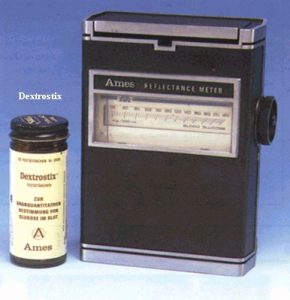ARTICLE SUMMARY:
In 1970, at the dawn of a decade that saw the birth of modern computing, disco, and the rise of female heads of state and government, a medical technology was developed that would forever change the way that diabetic patients self-manage their blood glucose levels: the blood glucose meter.
The year 1970, a half-century ago, marked the dawn of a turbulent decade that is remembered for the Vietnam War (that came to a close in 1975), a global recession and oil crisis, President Richard Nixon’s resignation, disco, the birth of modern computing (Apple Computer Company was founded in 1976), microwave ovens and VCRs, and the release of now-classic movies such as The Godfather, Star Wars,  The Exorcist, and Jaws. It was also a decade known for the rise of female heads of state and government, including Margaret Thatcher as the first woman Prime Minister of the United Kingdom, Soong Ching-ling as the first Chairwoman of the People's Republic of China, and Isabel Martínez de Perón as the first woman President in Argentina, among others.
The Exorcist, and Jaws. It was also a decade known for the rise of female heads of state and government, including Margaret Thatcher as the first woman Prime Minister of the United Kingdom, Soong Ching-ling as the first Chairwoman of the People's Republic of China, and Isabel Martínez de Perón as the first woman President in Argentina, among others.
As the 1970s began, the US Environmental Protection Agency began operation, the Treaty on the Non-Proliferation of Nuclear Weapons went into effect (India, Israel, Pakistan, and South Sudan have never signed it, and North Korea withdrew in 2003), and the first Boeing 747 jumbo jet went into service. In addition, the British-French supersonic passenger airliner, Concorde, made its first test flights exceeding the speed of sound, at Mach1 (767 mph) and Mach2 (1,534 mph; faster than the Earth rotates). Supersonic fact: In 1973, the Concorde made its first nonstop flight from Washington, DC to Paris in a  record-breaking three hours and 32 minutes, with the average round-trip ticket costing $12,000. The sleek luxury jet’s commercial lifespan was only 27 years, from 1976 to 2003.
record-breaking three hours and 32 minutes, with the average round-trip ticket costing $12,000. The sleek luxury jet’s commercial lifespan was only 27 years, from 1976 to 2003.
Also in 1970, a medical technology was developed that would forever change the way that diabetic patients manage their blood glucose levels. The first blood glucose meter, the Ames Reflectance Meter (ARM), invented by Anton H. Clemens, allowed patients, for the first time, to rapidly and easily self-monitor their blood glucose, with the goal of adjusting it to a near-normal range. This landmark invention for a complex disease rivals the discovery of life-saving insulin in the 1920s as an indispensable diabetes management tool.
Clemens’ ARM device, which weighed three pounds and cost $650 (about $4,300 today), was designed for use in a physician’s office. It incorporated a needle that indicated the intensity of blue light reflected from a paper strip, called Dextrostix. The meter gave a quantitative number that was correlated with glucose levels in blood that the Dextrostix was exposed to. The paper strip reagent technology was developed in the early 1960s by researchers at Ames. When the chemically treated strip was dipped into a drop of blood, it changed color to a shade of blue reflecting the level of glucose in the blood. The generated color was then visually compared to a chart on the bottle for an approximate assessment of blood glucose.
levels in blood that the Dextrostix was exposed to. The paper strip reagent technology was developed in the early 1960s by researchers at Ames. When the chemically treated strip was dipped into a drop of blood, it changed color to a shade of blue reflecting the level of glucose in the blood. The generated color was then visually compared to a chart on the bottle for an approximate assessment of blood glucose.
Clemens, a German-born electrical engineer turned inventor, joined Miles Laboratories (Elkhart, IN) in 1965 to help launch the company’s histology instrument program. He was serving as director of the Ames Instrument R&D Department at the time that he invented the ARM device. “I very strongly believed that from an engineering viewpoint it didn’t make any sense whatsoever to take a blood sample to a lab and then have an answer at best in three to four hours after and then make any judgment on diabetes management on the basis of that,” said Clemens, in a 1999 interview.
By the mid-1970s, the idea of patients using blood glucose data at home to better control their disease became a focus of product development, and by 1980, the Dextrometer was launched; this meter used Dextrostix along with a digital display. The Ames Division of Miles Laboratories launched the less expensive, portable, electronic Glucometer in 1981. At that point, self-monitoring of blood glucose became the standard of care, especially for patients with type 1 diabetes.
Technology to make blood glucose testing less painful and more continuous, portable, and digitally convenient for patients has advanced rapidly over the past 20 years. In 2017, the FDA approved Abbott Laboratories’ FreeStyle Libre Flash Glucose Monitoring System, the first continuous glucose monitor (CGM) for diabetics that doesn’t need backup fingerprick tests. The system uses a small sensor attached to the upper arm, over which patients wave a reader device to see the current blood sugar level and changes over the past eight hours. Abbott’s latest-generation FreeStyle Libre system provides real-time glucose readings for up to 10 days, and the touch-screen reader holds up to 90 days of data. Other competitors offer advanced CGM devices as well, and the technology continues to evolve. At issue now are regulatory, healthcare, and Medicare policies that support making CGM available, interoperable with other medical devices, and more affordable.
See our MedTech Strategist and Market Pathways article archives (including the articles noted on the right) for more on the latest innovations, company strategy, digital health, device interoperability, and regulation and reimbursement trends in the rapidly evolving diabetes management space.
![]() Trial MyStrategist.com and unlock 7-days of exclusive subscriber-only access to the medical device industry's most trusted strategic publications: MedTech Strategist & Market Pathways. For more information on our demographics and current readership click here.
Trial MyStrategist.com and unlock 7-days of exclusive subscriber-only access to the medical device industry's most trusted strategic publications: MedTech Strategist & Market Pathways. For more information on our demographics and current readership click here.
